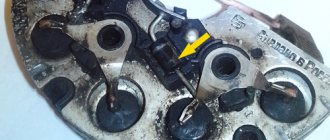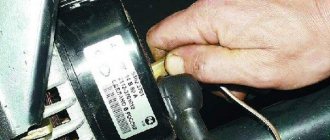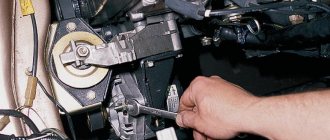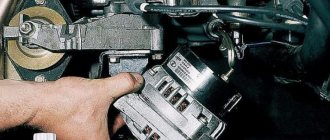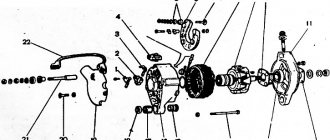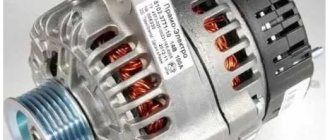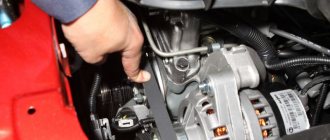07/17/2021 14,950 VAZ 2107
Author: Ivan Baranov
As with any car, the generator on the VAZ 2107 injector works in parallel with the battery - these are two power sources for the car, which are used in different modes. The article discusses the generator 37.3701, the principle of operation of the generator with different characteristics, including a maximum current of 80 Amperes, and provides instructions for connecting the unit. The G222 generator set is similar, you just need to pay attention to some differences.
[Hide]
Generator VAZ 2107: purpose and main functions
As with any other car, the generator on the “seven” works in tandem with a battery. That is, these are two power sources in the car, each of which is used in its own modes. And if the main task of the battery is to maintain the functionality of electronic devices during the period when the engine is turned off, then the generator, on the contrary, produces current only when the engine is running.
The main task of the generator set is to generate electrical energy by charging the battery. That is, in many ways (if not all) the performance of the machine depends on how well the generator and battery work.
Generator sets for the VAZ 2107 have been produced since 1982. Their factory marking is G-221A.
All VAZ classic cars, including model 2107, were equipped with G-221A generators
Technical characteristics of the generator G-221A
The VAZ 2107 was equipped with two types of generators (carburetor and injection), each of which had its own factory marking: 372.3701 or 9412.3701. Therefore, the operating characteristics of the devices may differ, since injection models consume more electricity, and accordingly, the generator power must be higher.
All VAZ 2107 generators have the same rated voltage - 14 V.
The generator for a carburetor car has modification 372.3701 and is made in an aluminum cast housing with steel fasteners
Table: comparison of characteristics of different modifications of generators for VAZ 2107
| Generator name | Maximum output current, A | Power, W | Weight, kg |
| VAZ 2107 carburetor | 55 | 770 | 4,4 |
| VAZ 2107 injector | 80 | 1120 | 4,9 |
Let's start the renovation
There may be several reasons for the battery not charging. The instructions below are quite universal and are suitable for any case.
Troubleshooting algorithm:
- First of all, we check the serviceability of the belt and its tension. If it is damaged or loose, charging will be less than normal and will ultimately lead to battery failure. The belt is also partly responsible for the operation of the cooling pump, so a damaged belt can cause other problems as well.
The problem can be determined by the sign when, when the engine is running, the voltage in the power circuit is within the normal range, but immediately after connecting the load it disappears. Another sign of a weak belt may be a whistling sound. It may appear immediately after starting the engine or when large current consumers, such as lights, are turned on.
This needs to be corrected, since a poorly tensioned belt slips during operation of the mechanism, which accelerates its wear. It must be tightened to a deflection level of 12 - 17 millimeters with a pressure of 10 kgf, or replaced with a new one;
- In order not to waste time and not draw false conclusions, you need to check the voltage on the battery with the engine stopped and running. The normal supply voltage of the machine when the engine is running should be 13.6 - 14.1 volts. A voltage below this will indicate a weak belt (point 1), a faulty regulator relay, or a failed diode bridge.
- If everything is fine with the belt, remove the charging relay and check the wear of the brushes. They should be longer than 5 millimeters, this can be seen visually, but to be sure, check with a ruler. If they malfunction, replace the VAZ 2021 charging relay.
You can check the relay by applying a battery voltage of up to 12 volts to it and connecting a multimeter to the brushes. There should be tension. Next, you need to apply a voltage of 16 - 18 volts to the relay. There should be nothing on the brushes;
- The next reason for low voltage is a break in one or more diodes. Revealed when removing and disassembling the generator.
It’s worse when a diode breakdown occurs, then there is no voltage drop, but this has a detrimental effect on the battery. An alternating voltage enters the machine's power circuit, which leads to boiling of the battery, destruction of the plates and a decrease in its service life.
- If the VAZ 2107 battery charging does not light up, or rather, the indicator light on the instrument panel does not light up, despite the fact that the voltage gauge shows normal voltage and despite all this there is no charging, then the problem lies in the contact at the terminals. To fix this, you need to disconnect the wire and clean it with sandpaper or a file and check the integrity of the wire from the battery to the generator.
- Another reason why the battery charge lamp does not light up at all is a break in the armature winding. It can only be determined after disassembling the generator and measuring the winding for an open circuit using a tester or a multimeter.
Below is a charging diagram for the VAZ 2107 battery:
What generators can be installed on the “seven”
The design of the VAZ 2107 allows the installation of not only the G-221A generator. Therefore, if necessary, the driver can install a more powerful device, however, this will require making some changes to the electrical circuit of the car. The question arises: what is the reason for the desire of a car enthusiast to change his “native” generator?
The G-221A was the optimal device for equipping cars at the beginning of their mass production. However, a lot of time has passed since the 1980s and today almost every driver uses modern electronic devices:
- acoustic system;
- navigators;
- additional lighting devices (tuning), etc.
Non-standard lighting devices consume the most electricity
Accordingly, the G-221A generator cannot cope with high loads, which is why drivers begin to look for more powerful units.
You can install at least three more powerful devices on the “seven”:
- G-222 (generator from Lada Niva);
- G-2108 (generator from the G8);
- G-2107–3701010 (injection model for a carburetor car).
It is important that the last two models do not require changes in the design of either the generator housing or its mountings. When installing a generator from Niva, you will have to make some modifications.
Video: principle of operation of the generator
Connection diagram G-221A
Being an electronic device, the generator needs to be used correctly. Therefore, its connection diagram should not cause ambiguity. It should be noted that drivers of “sevens” can usually easily connect all the generator terminals themselves, since the circuit is accessible and understandable to everyone.
The generator (item 2) is connected to the circuit in series between the battery (item 1) and the mounting block (item 3)
Many car owners wonder where which wire should be connected when replacing the generator. The fact is that the device has several connectors and wires, and when replacing, you can easily forget which wire goes where:
- orange is not useful for connection, it can be left as is or connected to gray directly to autostart the car;
- a gray thick wire goes to the brushes from the relay regulator;
- a gray thin wire connects to the relay;
- yellow - coordinator of the control light on the control panel.
When working independently with the G-221A, it is better to sign the purpose of the wires so as not to connect them by mistake later.
To avoid errors, all wires have their own color designation
What to choose?
In terms of popularity and reliability, the first places are occupied by manufacturers Bosch (Bosch), Denso (Denso) and Delphi (Delphi). But you should know that Katek (KZATE) (made by us) are also quite reliable and do a good job of their duties on the VAZ 2110, creating the required voltage. Maybe somewhere they lose against Bosch, but compared to the Chinese they are at their best.
VAZ generators of the tenth family:
So it’s difficult to say for sure which generator is right for you; the best one is the one that provides the necessary power to operate electrical appliances and charge the battery. If we take the advantages that Katek clearly has, then this is sufficient reliability, and also - what is important - the availability of inexpensive spare parts for sale: you can always buy at least a fuse, a pulley, an armature, a voltage regulator, an excitation wire, etc.
A car generator is a mandatory element of the on-board network of any modern car, regardless of the type of engine and the fuel it consumes. It is he who provides energy to all systems and mechanisms that consume electric current.
In this article we will look at the design, technical characteristics and operating principle of the VAZ-2110 generator. In addition, we will talk about its malfunctions, diagnostic methods and troubleshooting methods.
The device of the VAZ 2107 generator
Structurally, the generator on the “seven” has the shape of a cylinder. The cast body contains many small parts, each of which performs its own functions. The main elements of the G-221A are the rotor, stator and covers, which are cast only from a special aluminum alloy.
Rotor
The G-221A rotor consists of a shaft with a corrugated surface, onto which a steel sleeve and poles are pressed. The bushing and beak-shaped poles together form the so-called core of the electromagnet. The core produces an electromagnetic field during the rotation of the rotor shaft.
The excitation winding is also located inside the rotor. It is placed between the poles.
The moving element of the rotor - the grooved shaft - rotates thanks to two ball bearings . The rear bearing is mounted directly on the shaft, and the front bearing is fixed on the generator cover.
The rotor is pressed into the generator winding and does not separate from it during disassembly
Stator
The stator is assembled from special plates 1 mm thick. The plates are made of electrical steel. It is in the stator slots that the three-phase winding is located. The winding coils (there are six in total) are made of copper wire. Strictly speaking, the electromagnetic field coming from the rotor core is converted by the coils into pure electricity.
Wire breaks or carbon deposits on its surface can affect current generation
Rectifier
The generator in the described configuration produces only alternating current, which is clearly not enough for the smooth operation of the car. Therefore, in the G-221A case there is a rectifier (or diode bridge), the main task of which is to convert alternating current into direct current.
The diode bridge has the shape of a horseshoe (for which it received the corresponding nickname among car enthusiasts) and is assembled from six silicon diodes. On the plate, three diodes have a positive charge and three have a negative charge. A contact bolt is installed in the center of the rectifier.
Structurally, the rectifier really looks like a horse's horseshoe
Voltage regulator
The voltage regulator on the VAZ 2107 is made together with a brush holder. The device is a non-separable unit and is fixed to the back cover of the generator. The regulator is designed to maintain the rated voltage in the network in any operating mode of the engine.
The regulator's electrical circuit controls the voltage in the device
Pulley
The pulley is not always considered an integral part of the generator, since it is mounted separately on an already assembled housing. The main task of a pulley is to transmit mechanical energy. As part of the generator, it is connected by a belt drive to the crankshaft and pump pulleys. Therefore, all three devices work in an inextricable connection with each other.
The pulley is mounted on the rotor shaft and connected by a belt drive to the corresponding parts of the pump and crankshaft
Generator faults
Unfortunately, mechanisms have not yet been invented that would not fail under the influence of time and constant loads. The VAZ 2107 generator is designed for many years of operation, but in some cases this is hampered by minor breakdowns and malfunctions of its components.
You can identify problems with the generator without the help of service station specialists: you just need to carefully monitor all the changes that occur with the car while driving.
The charging indicator light on the instrument panel came on
In the interior of the VAZ 2107, there is a terminal for several signaling devices on the dashboard. One of them is the battery charging indicator light. If it suddenly lights up red, it means there is not enough charge in the battery or there is a problem with the generator. But the alarm does not always indicate a problem with the generator itself; most often the lamp goes off for other reasons:
- slipping of the generator belt drive - you will need to stop the machine and adjust the degree of belt tension;
- there is damage in the warning lamp relay, so it does not work correctly - it is recommended to “ring” the relay in the mounting block and, if necessary, replace it;
- breakage of contacts in the excitation winding is a more serious damage that requires removing the generator from the car, disassembling it and searching for a break;
- severe wear of the brushes in the brush holder - they will need to be replaced, which is quite simple;
- short circuit in the rectifier (most likely, one of the silicon diodes has burned out) - it is recommended to disassemble the generator, test the diodes and replace the failed element.
The driver will immediately notice the signal, as the lamp begins to glow bright red on the instrument panel
The battery is not charging
VAZ 2107 drivers often encounter this problem: the generator seems to be working properly, but there is no power to the battery. The problem may lie in the following malfunctions:
- the alternator belt has stretched - you need to check the degree of its tension or replace it with a new one;
- loosening the fastening of the wire tips - just tighten all the fastening connections and thoroughly clean the contacts and connectors;
- malfunction of the battery itself;
- Damage in the wiring - it is recommended to ring all the wires between the battery and the generator and replace the damaged areas.
If there is no charging, the problem may lie in both the generator and the battery.
The battery is boiling over
Battery boiling over is a sign that the battery does not have long life left. After this, the battery will not be able to function fully, so it will have to be replaced soon. However, so that the replacement does not lead to the same sad consequences, it is necessary to find the cause of the boiling, which may be:
- contamination of the contact between the ground and the housing of the generator regulator - cleaning of the contact is necessary;
- damage to the voltage regulator board itself - replacement of the board is recommended;
- defective battery - if the battery began to boil away immediately after replacement.
It is better not to use the battery after boiling, as its resource is very limited.
When driving there is noise and grinding noise from the generator
The generator has a rotating rotor, so it must make noise during operation. However, if these sounds become increasingly loud and unnatural, you should understand the cause of their occurrence:
- loosening the nut on the pulley - you need to tighten the nut and check the degree of belt tension;
- deterioration of the bearings - in this case, the driver may hear a loud grinding noise and even a howl while driving; it will be necessary to press out the old bearings from the shaft and install new ones;
- short circuit in the winding - the entire stator needs to be replaced;
- creaking brushes - it is recommended to clean the brushes from adhering dirt.
Some useful tips to extend the life of your generator
To ensure that your “ten” generator serves for a long time and does not present unpleasant surprises, use the following tips.
- At least once a month, check the condition of the device’s drive belt and its tension. If it is damaged, immediately take measures to replace it.
- Pay attention to the sound of the generator. If you hear a hum characteristic of failed bearings, replace them yourself, or contact a service center for this.
- Do not connect electrical appliances to the vehicle's on-board network that consume a current greater than the current generated by the generator.
- If the warning light on the instrument panel is constantly on, indicating that the battery is not charging, check the voltage regulator. If it fails, replace it.
- Do not expose the generator to water. It can cause a short circuit.
Generator check
Problems with the generator set can be avoided if the condition of this unit is periodically diagnosed. Checking the functionality of the generator gives the driver confidence that it is working properly and there is no cause for concern.
You cannot test the generator by disconnecting it from the battery while the engine is running. This is fraught with power surges and short circuits . The easiest way is to contact a service station specialist to check the functionality of the generator on a stand. However, convinced “seven guides” have long adapted to checking the G-221A on their own using a multimeter.
For diagnostics, you will need a multimeter of any type - digital or indicator. The only condition: the device must work correctly in both AC and DC measurement modes.
Operating procedure
Two people will be required to diagnose the generator's functionality. One of them should be in the cabin and, upon a signal, start the engine, the second should directly monitor the multimeter readings in different modes. The operating procedure will be as follows.
- Switch the device to constant current mode.
- With the engine turned off, connect the multimeter first to one terminal of the battery, then to the second. The network voltage should not be less than 11.9 and more than 12.6 V.
- After the initial measurement, start the engine.
- When starting the engine, the measurer must carefully monitor the instrument readings. If the voltage drops sharply and does not rise to operating condition, this indicates the exhaustion of the generator's life. If, on the contrary, the voltage indicator is higher than normal, then the battery will soon boil away. The best option is that when you start the engine, the voltage drops slightly and immediately recovers.
If the voltage measured with the engine running is between 11.9 and 12.6 V, then the generator is ok
Video: procedure for checking a generator with a light bulb
Check procedure for different engine operating modes
Since the sign of a generator malfunction is almost always the same, it is impossible to immediately identify the reasons why it failed without special equipment. There are 4 main failures due to which the generator may become inoperable.
Since it is not always convenient to check the generator on a car in the field, it is worth carrying out scheduled maintenance in advance and not neglecting the symptoms of imminent failure.
You need to know how to check the operation of the generator on a car correctly, otherwise you may encounter the fact that a working part will be completely damaged. By following just a few simple rules, you can avoid unexpected breakdowns.
The main condition under which it is possible to check a generator at home is to maintain its working condition. If the device is disassembled or has received damage that prevents it from functioning, then diagnostics will not allow us to determine the suitability of the device for further operation.
There is a list of actions that absolutely cannot be performed during verification:
There are two main verification methods. One of them, although very old, allows us to reliably understand the performance of the device. The second works more subtly and is able to respond to minor system flaws. Using the second method, you can identify the slightest deviations in the operation of each element.
Generator set belt for VAZ 2107
The VAZ 2107 car was produced from 1982 to 2012. Initially, the model was equipped with a smooth drive belt (old model). Over time, the “seven” was modified several times and at the end of the 1990s, the generator began to work with a new type of belt with teeth.
The most popular among car owners are rubber products from the German company. These belts fit perfectly into the operation of a domestic car and serve for the entire period specified by the manufacturer.
The operation of the generator and the entire vehicle depends on the quality of the drive belt.
The design numbers and sizes of the belts are indicated in the vehicle’s service book:
- 2101–1308020 (smooth surface), dimensions - 10.0x8.0x944.0 mm;
- 2107–1308020 (toothed surface), dimensions - 10.7x8.0x944.0 mm.
How to tension a belt on a generator
The operation of the generator, as well as the water pump, primarily depends on the correct tension of the belt on the pulley. Therefore, existing rules cannot be neglected. The belt is installed and tensioned in the following order.
- Place the assembled generator in place, lightly tightening the fixing nuts.
- Take a pry bar and use it to fix the gap between the generator housing and the pump.
- Place the belt on the pulley.
- Without releasing pressure from the pry bar, pull the belt onto the pulley.
- Tighten the top nut securing the generator until it stops.
- Check the degree of belt tension - the rubber should not sag, but it should not be too tight.
- Tighten the lower nut securing the generator.
A well-tensioned drive belt should give slight deflection when pressed, but not be excessively loose.
Video: how to tighten the alternator belt
Checking the degree of tension is done with two fingers. You need to press the free part of the belt and measure its deflection. The optimal deflection is 1–1.5 centimeters.
Thus, we can say that independent maintenance of the generator on a VAZ 2107 is quite possible and does not fall into the category of impossible tasks. It is important to follow the recommendations and algorithms for this or that work in order to carry out quality repairs or diagnostics. However, if you have doubts about your skills and abilities, you can always turn to professionals for help.
DIY Generator Connection Guide
The reason for replacing a VAZ 2107 generator with an injector or carburetor may be:
- burnt windings;
- an interturn short circuit has occurred;
- mechanical damage to the housing;
- malfunction of a three-level regulator, etc.
The generator replacement procedure consists of removal, installation and connection.
- First of all, we de-energize the car by removing the negative terminal from the battery.
- Disconnect the connector from the generator set.
Disconnecting the connector from the unit - Having removed the protective cover, you need to disconnect the terminal with a “10” key and remove the wire.
- After loosening the generator, you need to remove the drive belt.
- Using a “17” wrench, unscrew the nuts and remove the adjusting bar.
- After unscrewing the lower fastening nut, remove the bolt and bushing.
- We dismantle the generator.
Unit removed for repair
The generator set is installed in the reverse order. Before installing the unit, you need to thoroughly study the connection diagram of the 2107 generator with an injector or carburetor, as well as the electrical connection diagram. In this case, you need to pay attention to the difference between 37.3701 and G222.
After installation, you need to adjust the belt tension. To adjust the belt tension, you need to loosen the two bolts securing the unit. Using a pry bar, tighten the belt and secure it in this position with a nut on the adjusting plate. Then you need to check the degree of tension. To do this, you need to press the belt in the gap between the pulleys.
The deflection should be in the front from 10 to 17 mm. The procedure should be repeated until the desired value is achieved. After tensioning, all fastening nuts are finally tightened. At this point, the connection of the unit can be considered complete.
Modern cars are equipped with a large number of electronics, so the generator must be powerful to provide power to the on-board network and the operation of network elements. Therefore, you need to carefully monitor its technical condition.
